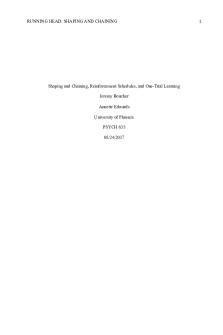Blocking , Overshadowing and Shaping PDF

| Title | Blocking , Overshadowing and Shaping |
|---|---|
| Author | Rhian Graham |
| Course | Learning Matters |
| Institution | University of Plymouth |
| Pages | 2 |
| File Size | 107 KB |
| File Type | |
| Total Downloads | 11 |
| Total Views | 136 |
Summary
Blocking , Overshadowing and Shaping...
Description
Pavlovian Conditioning: Blocking and Overshadowing
What do we learn:
To expect the US: 2 lines of evidence OR New response (to CS same as US) o Stimulus substitution
New response vs expectancy 1: The CR
CR=UR=Salivation CR not always same as UR o Shock conditioning: CR=fear, UR=pain CS produces anticipation of US
New response vs expectancy 2: US revaluation
CS family=US chocolate (associated with new response) US overeats chocolate=illness (expect chocolate, revaluate feeling towards family)
Overshadowing:
Stimuli compete for ‘associative strength’ Most ‘salient’ (noticeable) stimuli acquires most strength
Blocking:
Rescorla & Wagner (1972): o Don’t learn if not surprised = no associations o Learn association to asymptote, blocks second weaker association o Related to learning curve = completely expect = no surprise = asymptote
Asymptote Fast Learning
Explanation: o US supports certain amount of associative strength, shared between CS’s o A pretrained asymptote stimulus already has associative strength Already associated with US No strength left for other CS’s, pretrained CS=US not surprising
Mechanisms of learned behaviour
Shaping:
Emergence of new behaviours following reinforcement of successive approximations (shift criteria) Teaches complex behaviour/ different to existing repertoire Through stimulus control: o Thorndike: automatically elicit behaviour? Suggests no devaluing effect once response learned o Goal-directed, reward associated?
Occasion setting, Rescorla (1991):
Not stimulus-outcome, associated with both outcomes Not stimulus-response, associated with both responses
Actions and Habits: Packard & McGaugh (1996):
Condition 1: o Rat in cross, find food, trained by repeating o Edit starting point: goal=alter route / habit=same directions as before o Day 8: more goal, day 16: more habit Condition 2: o Deactivate caudate nucleus Day 8: more goal Day 16: more goal o deactivate hippocampus Day 8: same goal/habit = chance Day 16: bigger habit response...
Similar Free PDFs

Modeling, Shaping, and Chaining
- 8 Pages

Blocking Chart-Colour
- 1 Pages

JACKING BLOCKING LIFTING
- 9 Pages

laporan Mesin Shaping
- 18 Pages

Landscape shaping processes
- 3 Pages

Shaping New Tomorrow Projekt
- 31 Pages

Psych 282 - Chapter 9 - Shaping
- 4 Pages
Popular Institutions
- Tinajero National High School - Annex
- Politeknik Caltex Riau
- Yokohama City University
- SGT University
- University of Al-Qadisiyah
- Divine Word College of Vigan
- Techniek College Rotterdam
- Universidade de Santiago
- Universiti Teknologi MARA Cawangan Johor Kampus Pasir Gudang
- Poltekkes Kemenkes Yogyakarta
- Baguio City National High School
- Colegio san marcos
- preparatoria uno
- Centro de Bachillerato Tecnológico Industrial y de Servicios No. 107
- Dalian Maritime University
- Quang Trung Secondary School
- Colegio Tecnológico en Informática
- Corporación Regional de Educación Superior
- Grupo CEDVA
- Dar Al Uloom University
- Centro de Estudios Preuniversitarios de la Universidad Nacional de Ingeniería
- 上智大学
- Aakash International School, Nuna Majara
- San Felipe Neri Catholic School
- Kang Chiao International School - New Taipei City
- Misamis Occidental National High School
- Institución Educativa Escuela Normal Juan Ladrilleros
- Kolehiyo ng Pantukan
- Batanes State College
- Instituto Continental
- Sekolah Menengah Kejuruan Kesehatan Kaltara (Tarakan)
- Colegio de La Inmaculada Concepcion - Cebu








